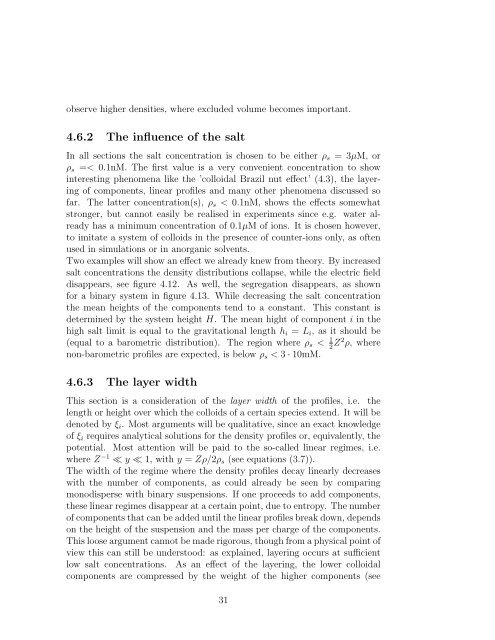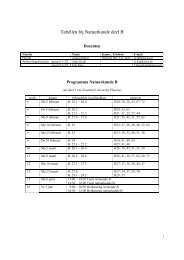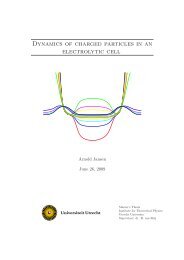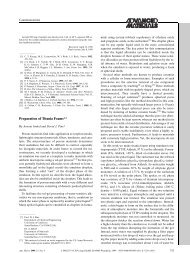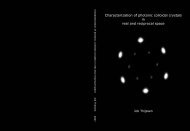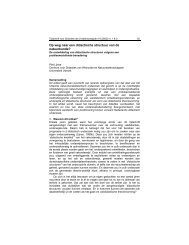Sedimentation Equilibrium of Mixtures of Charged Colloids
Sedimentation Equilibrium of Mixtures of Charged Colloids
Sedimentation Equilibrium of Mixtures of Charged Colloids
Create successful ePaper yourself
Turn your PDF publications into a flip-book with our unique Google optimized e-Paper software.
observe higher densities, where excluded volume becomes important.4.6.2 The influence <strong>of</strong> the saltIn all sections the salt concentration is chosen to be either ρ s = 3µM, orρ s =< 0.1nM. The first value is a very convenient concentration to showinteresting phenomena like the ’colloidal Brazil nut effect’ (4.3), the layering<strong>of</strong> components, linear pr<strong>of</strong>iles and many other phenomena discussed s<strong>of</strong>ar. The latter concentration(s), ρ s < 0.1nM, shows the effects somewhatstronger, but cannot easily be realised in experiments since e.g. water alreadyhas a minimum concentration <strong>of</strong> 0.1µM <strong>of</strong> ions. It is chosen however,to imitate a system <strong>of</strong> colloids in the presence <strong>of</strong> counter-ions only, as <strong>of</strong>tenused in simulations or in anorganic solvents.Two examples will show an effect we already knew from theory. By increasedsalt concentrations the density distributions collapse, while the electric fielddisappears, see figure 4.12. As well, the segregation disappears, as shownfor a binary system in figure 4.13. While decreasing the salt concentrationthe mean heights <strong>of</strong> the components tend to a constant. This constant isdetermined by the system height H. The mean hight <strong>of</strong> component i in thehigh salt limit is equal to the gravitational length h i = L i , as it should be(equal to a barometric distribution). The region where ρ s < 1 2 Z2 ρ, wherenon-barometric pr<strong>of</strong>iles are expected, is below ρ s < 3 · 10mM.4.6.3 The layer widthThis section is a consideration <strong>of</strong> the layer width <strong>of</strong> the pr<strong>of</strong>iles, i.e. thelength or height over which the colloids <strong>of</strong> a certain species extend. It will bedenoted by ξ i . Most arguments will be qualitative, since an exact knowledge<strong>of</strong> ξ i requires analytical solutions for the density pr<strong>of</strong>iles or, equivalently, thepotential. Most attention will be paid to the so-called linear regimes, i.e.where Z −1 ≪ y ≪ 1, with y = Zρ/2ρ s (see equations (3.7)).The width <strong>of</strong> the regime where the density pr<strong>of</strong>iles decay linearly decreaseswith the number <strong>of</strong> components, as could already be seen by comparingmonodisperse with binary suspensions. If one proceeds to add components,these linear regimes disappear at a certain point, due to entropy. The number<strong>of</strong> components that can be added until the linear pr<strong>of</strong>iles break down, dependson the height <strong>of</strong> the suspension and the mass per charge <strong>of</strong> the components.This loose argument cannot be made rigorous, though from a physical point <strong>of</strong>view this can still be understood: as explained, layering occurs at sufficientlow salt concentrations. As an effect <strong>of</strong> the layering, the lower colloidalcomponents are compressed by the weight <strong>of</strong> the higher components (see31


